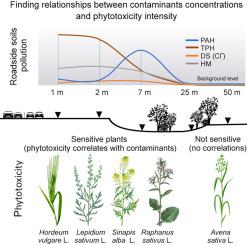Ecotoxicology and Environmental Safety ( IF 6.2 ) Pub Date : 2020-11-09 , DOI: 10.1016/j.ecoenv.2020.111586 Olga Nikolaeva , Mikhail Karpukhin , Rostislav Streletskii , Marina Rozanova , Olga Chistova , Nadezhda Panina

|
This research studies a typical landscape of an agricultural area separated from the road by a ditch with trees. Soils were sampled at 1, 2, 7, 25, and 50 m from the road. The concentrations of polycyclic aromatic hydrocarbons (PAH), total and phyto-available heavy metals (HM), total petroleum hydrocarbons (TPH), and de-icing salts (DS, Cl−) were determined using standard techniques. A set of higher plants (Lepidium sativum L., Sinapis alba L., Raphanus sativus L., Hordeum vulgare L., Avena sativa L.) was applied for toxicity evaluation of soils. The objective of this research is to find correlations between pollution of roadside soils and their phytotoxicity. HM, TPH and DS contamination of soils was observed in the 0–25 m zone, and PAH contamination was found up to the 50 m. Soil toxicity was declining from the road to the 50 m. Phytotoxicity related to majority of plants performed correlations with the same set of contaminants: TPH, 2-rings PAH, phyto-available Zn, Cu, Pb, and total Zn. No any correlations demonstrated Avena sativa L., being not applicable for ecotoxicological assessment of roadside soils. Despite the phytotoxicity was generally in line with contaminants loads, surprisingly low values were indicated in the ditch characterized by the strong pollution. We attribute this to the contrasting properties of soils there – the higher content of organics and clay. Sensitivity of plants to roadside pollution decreased in the row Lepidium sativum L. > Hordeum vulgare L. > Sinapis alba L. > Raphanus sativus L. The most reliable test-parameters for toxicity estimation were the root and the shoot length, germination rate was not informative indicating low phytotoxicity values. The research showed the importance of the right choice of test-cultures and test-parameters to judge phytotoxicity correctly. Linking the contaminants loads and phytotoxicity effects is valuable for comprehensive ecotoxicological assessment.
中文翻译:

将路旁土壤的污染与五种高等植物的生态毒理响应联系起来
这项研究研究了一个农业区域的典型景观,该区域被树木沟与道路隔开。在距离公路1、2、7、25和50 m处对土壤进行了采样。多环芳烃(PAH)(HM)的浓度,总和植物可用的重金属,总石油烃(TPH)和除冰盐(DS,氯-使用标准技术测定)。一组高等植物(的独行菜豌豆L.,白芥属,萝卜大号。,大麦L. ,燕麦大号。)用于土壤毒性评估。这项研究的目的是发现路旁土壤的污染与其植物毒性之间的关系。在0–25 m区域观察到土壤的HM,TPH和DS污染,而在50 m处发现了PAH污染。从道路到50 m,土壤毒性正在下降。与大多数植物有关的植物毒性与一组相同的污染物相关:TPH,2-环多环芳烃,植物可利用的锌,铜,铅和总锌。没有任何相关证明燕麦大号。,不适用于路边土壤的生态毒理评估。尽管植物毒性通常与污染物的含量一致,但在沟渠中却显示出令人惊讶的低值,其特征是强烈的污染。我们将其归因于那里土壤的对比特性–有机物和粘土的含量更高。植物路边空气污染的敏感度在下降一行独行菜豌豆大号。 >大麦(Hordeum vulgare L.)>芥菜(Sinapius alba L.)>萝卜(Raphanus sativus)L.估计毒性最可靠的测试参数是根部和枝条长度,发芽率,不足以表明低植物毒性值。研究表明正确选择测试培养物和测试参数对正确判断植物毒性的重要性。将污染物的负荷量与植物毒性作用联系起来,对于全面的生态毒理学评估非常有价值。











































 京公网安备 11010802027423号
京公网安备 11010802027423号